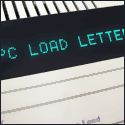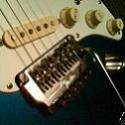|
The feedback setting sends that operator's output into its own modulation input, as if the algorithm had an additional operator going into that one with the same freq & envelope settings.
|
|
|
|

|
| # ? Jun 2, 2024 16:33 |
|
I am so stoked right now, you have no idea. RYMCast lets you rip any patch from a Sega Genesis track. So naturally, I had to pull the bass patch from Green Hill Zone. It's one of my favorite bass instruments ever. It has just the right mix of bassiness, brightness, and punch, and I love it to death. When I ripped it and tried it out, though, it sounded...wrong. It felt muddy and muted, and I wasn't sure what went wrong. I tried adding a high pass filter and all sorts of fuckery with a 5 EQ, but nothing got close, and I still had no idea what the difference actually was. So I clipped the ripped patch and a snippet from Green Hill Zone in Audacity, and compared their spectrums. Mine:  Theirs:  That didn't make any sense. This was the exact patch used in Green Hill Zone, and it sounded perfectly normal in RYMCast (and I've certainly never emulated the game before but I'm told it's normal there too). How come it sounded different when I used it? Looking at the spectrum, I noticed that there was more emphasis on frequencies around 2kHz in the original patch, and more around 1kHz in the ripped patch. I was reading FM Synthesis of Real Instruments earlier today, and according to that text, if frequencies other than the fundamental harmonic show up in the spectrum, that's because a modulator put them there. Considering that the patch sounded muddy and not bright or "spiky" enough, what if the problem was with one of the modulator's ratios? Every ratio was set to 1.0 except for the topmost operator, the one with feedback. That one was set to 10. I bumped it up to 15, and wouldn't you know, it started sounding very familiar. Spectrum analysis backed me up: Mine, higher ratio:  Theirs:  But it wasn't quite there. Clearly, the ratio was somehow loaded incorrectly when importing the patch, so just bump up the ratio for more brightness, right? Problem is, the maximum ratio on the YM2612 is 15 - you can't go any higher. But there's got to be a way to fix it, and here I got curious. Since this is a matter of ratios, what are they supposed to be? I would be hosed if it wasn't for the fact that RYMCast's patches are just plain XML, thank god. That let me check what the ratios are in the file, and: code:code: Yup, RYM2612 doesn't properly interpret ratios from its own patch format! The operators are supposed have a ratio of 1:1:1:20, but it gets imported as 1:1:1:10 instead. I have no idea why. So, I need to get an effective ratio of 1:1:1:20 while still working within the 15-ratio maximum. That's simple: just drop it by half instead, and set a ratio of 0.5:0.5:0.5:10. Mine, corrected:  Theirs:  This patch has been my white whale for years. I've always wanted to play around with it. And now, I have it. and I spent way too much effort trying to get it Here's a comparison of the different patches: original, raw ripped, 1:1:1:15, 0.5:0.5:0.5:10.
|
|
|
|
Pollyanna posted:For example, for a bass guitar, knowing that there's a beginning percussive "chk" part when the bass is first struck, then a relatively quick decaying high-resonance part (what is resonance?), then a long-term sustaining resonant part that stays at roughly the same level, then finally an ending part that decays quickly from medium resonance to silence. (Interestingly enough, his assessment matches up with the ADSR of a bass guitar. hmmmm For a piano, you have something called "sympathetic resonance" which means that an open string at say, C4 will start moving when you play a C3. This happens for octaves but not for other notes. Detuning: If you have an even ratio - B modulates A and B's frequency is twice as high as A's (ratio is 2:1), then you get a very clean and stable sound. If you choose an odd ratio (3:1, 5:1), you get something that's more interesting. If you choose a ratio that's not an integer - i.e. 2.7647:1 the sound gets quite a bit of motion and starts to sound inharmonic. However, this effect may lessen again when using halves - i.e. 2.5:1. This means that if you want subtle motion in your sound (and in each component), you can choose to add a little bit of detuning; if you have 3 operator pairs and you all give them different detunings, you'll get a warbling sound. The levels matter in such a way that it just gets a lot less subtle when you turn them up. Keep in mind that the levels can be controlled by velocity and their amounts don't have to be equal. This gets interesting when you get a 2x3 or 3x2 structure - each "layer" can react differently to a velocity, so if you whack the key like it owed you money you could emphasize that percussive "chk" but leave the core tone relatively intact. As for knowing how to program FM patches: I think someone got an oscilloscope and a nice spectrum analyzer and worked backwards from that. I'm reasonably certain that there's some kind of Fourier series approximation formula or so. But yeah, think in layers/components.
|
|
|
|
If you can shoot Inphonik support an email about that, seems like a pretty fixable bug and well worth letting them know about. I haven't noticed it yet, and would even have said for sure it gets the game sounds right into your DAW based on what I used it for. Sounded straight out of the Genesis to my ears, but my ears are not as precise as a spectrum analysis.
|
|
|
|
Pollyanna posted:I am so stoked right now, you have no idea. good effortpost thank you
|
|
|
|
^^ no prob Holy poo poo there’s so many goddamn synths out there. I do want something physical, just cause it’s easier to jam on. A DAW is great for when it’s time to commit, but I’m getting pretty sick of mashing zcbbbbzfvxgnnnn. Plus I want an excuse to set up a little workstation. Probably just something simple for now. Something cheap, monophonic, typical subtractive synthesis. There’s always the Microbrute and my friend has one and I found it to be pretty okay. Edit: also, it’d be phenomenal to have something that could record snippets or something, so I don’t have to get up out of bed to record something in Renoise when I inevitably come up with something while I’m trying to get to sleep. Any intro synths that sound like a match for that? Pollyanna fucked around with this message at 03:34 on Oct 8, 2021 |
|
|
|
I don't have anything to add, apart from some appreciation for the discussion taking place. Thanks for sharing, everyone. It's fascinating reading, and I'm learning quite a bit from y'all. Eta Pollyanna posted:Intro synth question snipped B33rChiller fucked around with this message at 03:54 on Oct 8, 2021 |
|
|
|
Pollyanna posted:It's pretty good, actually. Video Guy's advice pretty much breaks down to the following: have you thought about writing a book? that was intense.. but excellent . my hydrasynth has unusual FM synthesis, and i’m not sure i can acheieve all of that but maybe close. Also that was the best view into the mindset of creating a patch with FM. better than the video. wow one question you asked : why detune? just coz if the oscillators are slightly out of tune from each other it makes the sound much wider and more massive. adds movement.
|
|
|
|
My entire fm philosophy is "gently caress with things until I get a uk bass sort of sound" and I can say I've reached this point easily enough. I didnt realize operator in ableton is fm until recently, so I've effectively been doing fm synthesis for a decade
|
|
|
|
Are there any options for a midi USB XY pad to use with Ableton, I guess like the Korg Nanopad, but just the XY pad part? There seems to be the Nanopad, and stuff like the Kaosspad, and I guess some midi controllers with XY joysticks, but does anybody make something that is just an XY touchpad with midi over USB? If there's nothing like that, anybody have hands experience with the Nanopad2? Does the XY touchpad work well in Ableton?
|
|
|
|
I freaking wish there was. You can make your own from a touchpad but I didn't, I just use the Nanopad 2. To use it as an X/Y I MIDI-assign the X and Y separately to the appropriate parameters, I don't know if there's an easier way than that but it works great for X/Y pad usage this way in whatever application I've wanted to use it for.
|
|
|
|
Agreed posted:I freaking wish there was. You can make your own from a touchpad but I didn't, I just use the Nanopad 2. To use it as an X/Y I MIDI-assign the X and Y separately to the appropriate parameters, I don't know if there's an easier way than that but it works great for X/Y pad usage this way in whatever application I've wanted to use it for. Thanks. So the Nanopad 2 at least works as I'm hoping, and I can just plug it in and control the Ableton XY pad feature? It seems like that's what it should do, and that seems like it would be awesome in Ableton, but some googling revealed some people complaining about configuring the Nanopad2. Do you just midimap the two axes in Ableton?
|
|
|
|
I wish I could help with that particular question but I don't use Ableton. It has not had any trouble assigning for any of the other stuff I've used it for, including a bunch of standalone applications and in Reaper, but I don't know about that in particular. I would wonder why, though, I am pretty sure it is deriving its functionality from being a class compliant MIDI device as it is configured. You turn off the pad's tuning mode and enable the X/Y midi function in the software, I think, it's been a few months since I set it up and I haven't opened the software since so it's a little fuzzy y'all. But it's just an editor from their site that lets you adjust the pad values etc. and one of the things you can change iirc is how the pad works. Set it up right and it should work fine, I would think, unless there is a specific bug I don't know about. I like their NanoKontrol2 also, for as tiny as it is it is very handy when used with the Mackie control surface emulating stuff you can install for Reaper. Makes it just work as you'd want it to out the gate.
|
|
|
|
This week was good for burning down some of the synth fixing & modding to-dos on my list: 1. Main voice board swap on Prophet-10 with proper/repaired board (mine was in the range of Prophets with the two capacitors populated on the board that shouldn't have been, and affected high-end frequency output) 2. Prophet-10 keybed mounted and secured with screws to floor of chassis 3. MUSE installed in Minimoog Model D reissue 4. New wood cheeks swapped on to Prophet-6 desktop module replacing somewhat beat up cheeks 5. Grey Matter E! card in the DX7IIFD I still have some older other pending repairs on the bench (or more accurately, on the stack), but felt pretty good about getting these cleared off the deck.
|
|
|
|
McCoy Pauley posted:Are there any options for a midi USB XY pad to use with Ableton, I guess like the Korg Nanopad, but just the XY pad part? There seems to be the Nanopad, and stuff like the Kaosspad, and I guess some midi controllers with XY joysticks, but does anybody make something that is just an XY touchpad with midi over USB? There's the ROLI Lightpad. I've even written some apps for it. Be aware that the company is a startup; they are rebranding focusing on more beginner hardware instead.
|
|
|
|
Been really enjoying this NTS-1 a lot over the past couple days since I assembled it, boy is it a hoot. I've tried using the librarian but it wasn't working, but it was with an old Windows 7 computer that has problems with its USB connectors anyway, so I'm holding out hope that when I actually connect it to a Windows 10 machine it will properly work. As much as I've enjoyed it it won't be right without that. But I've been Floyding out over here bigtime, just with this tiny box.
|
|
|
|
|
petit choux posted:Been really enjoying this NTS-1 a lot over the past couple days since I assembled it, boy is it a hoot. I've tried using the librarian but it wasn't working, but it was with an old Windows 7 computer that has problems with its USB connectors anyway, so I'm holding out hope that when I actually connect it to a Windows 10 machine it will properly work. As much as I've enjoyed it it won't be right without that. Here's the reminder to install the korg driver, have as little else plugged in to USB as possible, and to plug the nts1 directly into your computer (avoid hubs). Both going through a hub, and having a midi keyboard plugged in caused me issues separately while trying to use the librarian. Hopefully that works for you. They're great little boxes, even just for the fx.
|
|
|
Martytoof posted:
After you spend some more time with it, you should return to the one and see if it's changed your workflow to the point that the one makes more sense
|
|
|
|
|
Google Butt posted:After you spend some more time with it, you should return to the one and see if it's changed your workflow to the point that the one makes more sense I have a strong suspicion it has already made the workflow feel more familiar and natural, but I also think it will have trained me to hate the touch aspect of the interface even more than I did when I was just learning. I am seriously over the moon with how I can do everything on the 1K with a combination of the shift button, pads, data entry wheel, and F-keys. Apropos of nothing: 
some kinda jackal fucked around with this message at 00:56 on Oct 10, 2021 |
|
|
|
 WHAT?! Please tell me that’s Dr. John Chowning’s dissertation or something.
|
|
|
|
I have no idea, sorry to disappoint, just something I found on imgur randomly  Synths and Synthesis MkII: The waveform is changed by tickling
|
|
|
|
After a sort of synth nerd jam session last week I'm trying to work out a bit more of a live setup. I'm getting rid of my OP-Z and getting a Wavedrum, planning to sort of move between Wavedrum and Seaboard for the next get-together. It's also getting me to finally learn how to use my Launchstation in Bitwig, which is great because it was just gathering dust up until now.
|
|
|
|
Tickling is such an apt word for fm modulation lol
|
|
|
|
|
So Math posted:There's the ROLI Lightpad. I've even written some apps for it. Be aware that the company is a startup; they are rebranding focusing on more beginner hardware instead. They straight up went bankrupt. I don't think anyone should expect their previous products to be sold or supported at all moving forward. B33rChiller posted:Here's the reminder to install the korg driver, have as little else plugged in to USB as possible, and to plug the nts1 directly into your computer (avoid hubs). Lol my second one (after I RMAed the first with the faulty USB) has also stopped even showing up as a USB device. This could be related to my kid knocking it off a table, but I'm starting to also think that they may just have garbage USB connectors or something. I'm pretty tempted to try soldering a new one in and seeing what happens.
|
|
|
|
Hey, BTW, anybody have any experience with Zeppelin Design Labs? They are offering an optical theremin kit that looks great, and a couple DIY synth kits kinda similar to the nts-1. https://www.etsy.com/listing/573261...WxoC6hAQAvD_BwE
|
|
|
|
|
I think I’m going to re buy the TR-8 I really miss it. The gated reverb and side chain effects are really good and I need an 808 again
|
|
|
|
|
Bought a sampler from a goon it still had various permutations of the It is Wednesday My Dudes that the previous owner had been playing with.
|
|
|
|
|
A MIRACLE posted:I think I’m going to re buy the TR-8 Get a TR8S
|
|
|
|
FYI, you owe it to yourself to get a Roland System-1. It may be the first synth I own that I may sell off but it sounds way better than you'd expect. https://www.youtube.com/watch?v=UMPvdA-01tM That pad just after 3:15 with the random LFO is basically the entire reason I bought mine. Catastrophe fucked around with this message at 03:35 on Oct 11, 2021 |
|
|
|
That has four voices right? If you sell it post it here again
|
|
|
|
|
what do people think about the digitone. I am extremely intrigued by it.
|
|
|
|
echinopsis posted:what do people think about the digitone. I am extremely intrigued by it. It's awesome. You can have a lot of fun just dialing different sounds and sequencing on the thing, and while I can't say I fully understand the mysteries of FM synthesis, it's really easy to adjust parameters and see/hear what you're doing until you arrive at something you like. And you can get a wide range of sounds, including lots percussion that let you basically use the thing like a groovebox to lay down drums and then synth over them. Elektron's sequencer, with parameter locks, is really powerful -- the DN having only 4 tracks sounds like it would be limiting, but you can use the sequence and p-locks in creative ways to create tracks with a lot going on. And it just feels good to use -- the screen is excellent, the controls are well made and responsive, and the whole thing is built like a tank. There are obviously lots of videos people doing interesting things with the DN, but I particularly like Ivar Tryti's stuff -- he has some good instructional videos that are really helpful for learning how to create bass, leads, drums, etc. I watched all his stuff when I first got mine and it helped me wrap my head around what the DN could do. Bottom line is that the digitone is awesome, and you should get one.
|
|
|
|
Get the keyboard because they’re the only company still brave enough to do the side by side layout. You can put the soft kb on the module side at a different octave, I use it like pedal bass
|
|
|
|
I like my Digitone. It's not a super in depth implementation of FM (which is fine by me) but it's fast to use plus the elektron workflow is great. E: If you're ok with buying used guitar center usually has them at the best price for a used one. net work error fucked around with this message at 16:42 on Oct 11, 2021 |
|
|
|
The difficulty of FM synthesis (afaict) really boils down to the difficulty of understanding the role of harmonics in synthesized sound, how those harmonics determine the timbre of an FM sound, and how to sculpt the harmonic range of an FM sound over time using the algorithms and envelopes on an FM synth. None of that is simple Also the “using the algorithms and envelopes” part is equivalent to the most bizarre and complicated chisel you’ve ever seen, so it’s Calvinball for all intents and purposes. FM synthesis is more like discovery than engineering.
|
|
|
|
I fuckin love FM synthesis and am about to get that Plogue yamaha vst Discovery is what makes music music for me!
|
|
|
|
drat I want one. They're about $1800nzd and I can't see any on the 2nd hand market at the moment. If I could get it for around $1000nzd I would, and that's about the second hand price, but I doubt many people around the world are prepared to ship to nz, and I'd have no idea what to check to trust it wasn't a scam or broken etc. Maybe one will pop up on the second hand market soon.
|
|
|
|
The digitone was pretty great for sequencing my little drum machine I had at the time too. You get four midi tracks so I had them all on the same channel and used them as mute groups
|
|
|
|
|
I feel like I need just one more thing that can make sound and is easily accessible. what’s it like for “live” stuff? like does it require lots of hunched over diving in menus or can you whip up a quick sequence and dial in the sounds on the fly pretty easily?
|
|
|
|

|
| # ? Jun 2, 2024 16:33 |
|
If you can afford to spend several hundred dollars on a sequencing device and you don’t have a basic iPad you should get one, ideally one with a USB port but even a basic one with Lightning for like $250 works wonders as a controller
|
|
|



















 )
)























